 W
WThe Admiralty, originally known as the Office of the Admiralty and Marine Affairs, was the government department responsible for the command of the Royal Navy first in the Kingdom of England, later in the Kingdom of Great Britain, and from 1801 to 1964, the United Kingdom and former British Empire. Originally exercised by a single person, the Lord High Admiral (1385–1628), the Admiralty was, from the early 18th century onwards, almost invariably put "in commission" and exercised by the Lords Commissioners of the Admiralty, who sat on the Board of Admiralty.
 W
WThe Air Ministry was a department of the Government of the United Kingdom with the responsibility of managing the affairs of the Royal Air Force, that existed from 1918 to 1964. It was under the political authority of the Secretary of State for Air.
 W
WThe Allied Forces Act 1940 was an act of Parliament of the Parliament of the United Kingdom passed in late 1940, after the fall of France.
 W
WThe Anglo-Soviet Agreement was a formal military alliance that was signed by the United Kingdom and the Soviet Union against Nazi Germany on July 12, 1941, shortly after the beginning of Operation Barbarossa, the German invasion of the Soviet Union. Both powers pledged to assist each other and not to make a separate peace with Germany. The military alliance was to be valid until the end of World War II.
 W
WThe Anglo-Soviet Treaty, formally the Twenty-Year Mutual Assistance Agreement Between the United Kingdom and the Union of Soviet Socialist Republics, established a military and political alliance between the Soviet Union and the British Empire that was to last until the end of World War II or 20 years, whichever occurred later.
 W
WThe Anglo-Thai Peace Treaty signed in Singapore on 1 January 1946 ended the state of war that had existed between Thailand and the United Kingdom since the former's declaration of war of 25 January 1942 during World War II. Although the Thais had also declared war on the United States on the same day, a U.S.–Thai peace treaty was never signed because the American government opted not to recognise the legality of the declaration in light of the Japanese invasion of Thailand on 8 December 1941.
 W
WThe Atlantic Charter was a statement issued on 14 August 1941 that set out American and British goals for the world after the end of World War II.
 W
WBritish shadow factories were the outcome of the Shadow Scheme, a plan devised in 1935 and developed by the British Government in the buildup to World War II to try to meet the urgent need for more aircraft using technology transfer from the motor industry to implement additional manufacturing capacity.
 W
WThe Catterick Bridge Explosion occurred on 4 February 1944 in the railway sidings at Catterick Bridge station, on the Richmond Branch Line/Catterick Camp Railway in North Yorkshire, England. It killed twelve people and injured more than a hundred. The incorrect loading of explosives into railway wagons is believed to have been the cause, but because of wartime restrictions, reporting of the event was not as widespread as it would have been had the explosion occurred in peacetime.
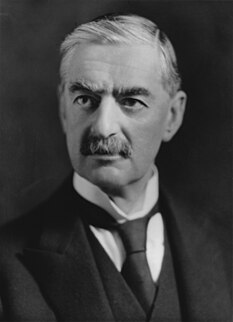 W
WNeville Chamberlain formed the Chamberlain war ministry in 1939 after declaring war on Germany. Chamberlain led the country for the first eight months of the Second World War, until the Norway Debate in Parliament led Chamberlain to resign and Winston Churchill to form a new ministry.
 W
WThe Churchill caretaker ministry was a short-term United Kingdom (UK) government during the latter stages of the Second World War, from 23 May to 26 July 1945. The prime minister was Winston Churchill, leader of the Conservative Party. This government succeeded the national coalition which he had formed after he was first appointed prime minister on 10 May 1940. The coalition had comprised leading members of the Conservative, Labour and Liberal parties and it was terminated soon after the defeat of Nazi Germany because the parties could not agree on whether it should continue until after the defeat of Japan.
 W
WThe Churchill war ministry was the United Kingdom's coalition government for most of the Second World War from 10 May 1940 to 23 May 1945. It was led by Winston Churchill, who was appointed Prime Minister by King George VI following the resignation of Neville Chamberlain in the aftermath of the Norway Debate.
 W
WThe 1944 Commonwealth Prime Ministers' Conference was the first Meeting of the Heads of Government of the British Commonwealth. It was held in the United Kingdom, between 1–16 May 1944, and was hosted by that country's Prime Minister, Winston Churchill.
 W
WThe Dumbarton Oaks Conference or, more formally, the Washington Conversations on International Peace and Security Organization was an international conference at which the United Nations was formulated and negotiated among international leaders. The conference was held at Dumbarton Oaks, in Washington, D.C., from August 21, 1944, to October 7, 1944.
 W
WThe Emergency Powers (Defence) Act 1939 was emergency legislation passed just prior to the outbreak of World War II by the Parliament of the United Kingdom to enable the British Government to take up emergency powers to prosecute the war effectively. It contained clauses giving the government wide powers to create Defence Regulations which regulated almost every aspect of everyday life in the country. Two offences under the regulations were punishable with death.
 W
WOperation Fish was the World War II evacuation of British wealth from the UK to Canada. It was the biggest known movement of wealth in history.
 W
WThe Foreign, Commonwealth & Development Office (FCDO), formerly known as the Foreign & Commonwealth Office (FCO) until September 2020, and commonly called the Foreign Office (FO), is a department of the Government of the United Kingdom. It is responsible for protecting and promoting British interests worldwide and was created in 1968 by the merger of the Foreign Office and the Commonwealth Office.
 W
WA Franco-British Union is a concept for a union between the two independent sovereign states of the United Kingdom and France. Such a union was proposed during certain crises of the 20th century; it has some historical precedents.
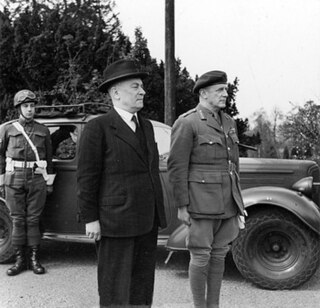 W
WThe Belgian government in London, also known as the Pierlot IV Government, was the government in exile of Belgium between October 1940 and September 1944 during World War II. The government was tripartite, involving ministers from the Catholic, Liberal and Labour Parties. After the invasion of Belgium by Nazi Germany in May 1940, the Belgian government, under Prime Minister Hubert Pierlot, fled first to Bordeaux in France and then to London, where it established itself as the only legitimate representation of Belgium to the Allies.
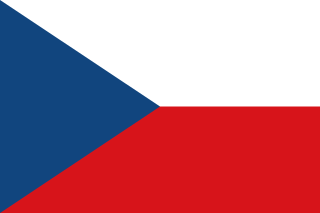 W
WThe Czechoslovak government-in-exile, sometimes styled officially as the Provisional Government of Czechoslovakia, was an informal title conferred upon the Czechoslovak National Liberation Committee, initially by British diplomatic recognition. The name came to be used by other World War II Allies as they subsequently recognised it. The committee was originally created by the former Czechoslovak President, Edvard Beneš in Paris, France, in October 1939. Unsuccessful negotiations with France for diplomatic status, as well as the impending Nazi occupation of France, forced the committee to withdraw to London in 1940. The Czechoslovak Government-in-Exile offices were at various locations in London but mainly at a building called Fursecroft.
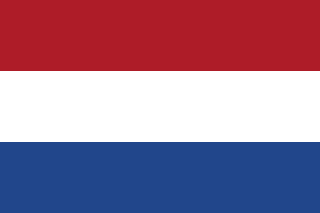 W
WThe Dutch government in exile, also known as the London Cabinet, was the government in exile of the Netherlands, headed by Queen Wilhelmina, that evacuated to London after the German invasion of the country during World War II on 10 May 1940.
 W
WThe Luxembourgish government in exile, also known as the Luxembourgish government in London, was the government in exile of Luxembourg during the Second World War. The government was based in London between 1940 and 1944, while Luxembourg was occupied by Nazi Germany. It was led by Pierre Dupong, and also included three other Ministers. The head of state, Grand Duchess Charlotte, also escaped from Luxembourg after the occupation. The government was bipartite, including two members from both the Party of the Right (PD) and the Socialist Workers' Party (LSAP).
 W
WThe Polish government-in-exile, officially known as the Government of the Republic of Poland in exile, was the government in exile of Poland formed in the aftermath of the Invasion of Poland of September 1939, and the subsequent occupation of Poland by Germany and the Soviet Union, which brought to an end the Second Polish Republic.
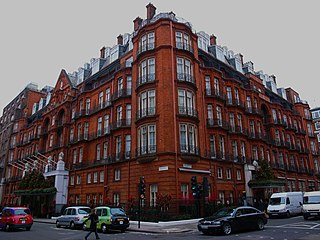 W
WThe Government of the Kingdom of Yugoslavia in Exile was an official government of Yugoslavia, headed by King Peter II. It evacuated from Belgrade in April 1941, after the Axis invasion of the country, and went first to Greece, then to Palestine, then to Egypt and finally, in June 1941, to the United Kingdom.
 W
WGuy Motors was a Wolverhampton-based vehicle manufacturer that produced cars, lorries, buses and trolleybuses. The company was founded by Sydney S. Guy (1885–1971) who was born in Kings Heath, Birmingham. Guy Motors operated out of its Fallings Park factory from 1914 to 1982, playing an important role in the development of the British motor industry.
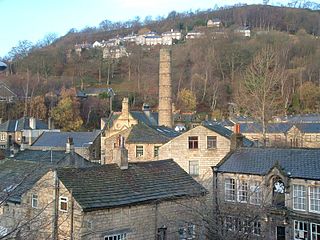 W
WHebden Bridge is a market town in the Upper Calder Valley in West Yorkshire, England. It is 8 miles (13 km) west of Halifax and 14 miles (21 km) north-east of Rochdale, at the confluence of the River Calder and the Hebden Water. The town is the largest settlement in the civil parish of Hebden Royd.
 W
WJ.L. Thompson and Sons was a shipyard on the River Wear, Sunderland, which produced ships from the mid-18th century until the 1980s. The world-famous Liberty Ship was among the designs to be created, produced and manufactured at the yard's base at North Sands.
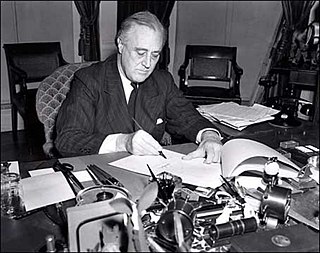 W
WThe Lend-Lease policy, formally titled An Act to Promote the Defense of the United States, was a program under which the United States supplied the United Kingdom, Free France, the Republic of China, and later the Soviet Union and other Allied nations with food, oil, and materiel between 1941 and August 1945. This included warships and warplanes, along with other weaponry. It was signed into law on March 11, 1941, and ended in September 1945. In general the aid was free, although some hardware were returned after the war. In return, the U.S. was given leases on army and naval bases in Allied territory during the war. Canada operated a similar smaller program called Mutual Aid.
 W
WMetro-Cammell, fully the Metropolitan Cammell Carriage and Wagon Company (MCCW) was an English manufacturer of railway carriages, locomotives and railway wagons, based in Saltley and subsequently Washwood Heath in Birmingham. Purchased by GEC Alstom in May 1989, the factory was closed by its eventual owner Alstom in 2005.
 W
WThe Ministry of Information (MOI), headed by the Minister of Information, was a United Kingdom government department created briefly at the end of the First World War and again during the Second World War. Located in Senate House at the University of London during the 1940s, it was the central government department responsible for publicity and propaganda.
 W
WThe Monument to the Women of World War II is a British national war memorial situated on Whitehall in London, to the north of the Cenotaph. It was sculpted by John W. Mills, unveiled by Queen Elizabeth II and dedicated by Baroness Boothroyd in July 2005.
 W
WThe National Registration Act 1939 was an Act of Parliament in the United Kingdom. The initial National Registration Bill was introduced to Parliament as an emergency measure at the start of the Second World War.
 W
WA Nissen hut is a prefabricated steel structure for military use, especially as barracks, made from a half-cylindrical skin of corrugated iron. Designed during the First World War by the American-born, Canadian-British engineer and inventor Major Peter Norman Nissen, it was used also extensively during the Second World War and adapted to the similar Quonset hut in the United States.
 W
WThe Northern Counties Motor & Engineering Company was an English builder of bus and coach bodywork based in Wigan.
 W
WOperation Bernhard was an exercise by Nazi Germany to forge British bank notes. The initial plan was to drop the notes over Britain to bring about a collapse of the British economy during the Second World War. The first phase was run from early 1940 by the Sicherheitsdienst (SD) under the title Unternehmen Andreas. The unit successfully duplicated the rag paper used by the British, produced near-identical engraving blocks and deduced the algorithm used to create the alpha-numeric serial code on each note. The unit closed in early 1942 after its head, Alfred Naujocks, fell out of favour with his superior officer, Reinhard Heydrich.
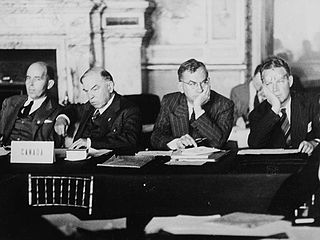 W
WThe Paris Peace Treaties were signed on 10 February 1947 following the end of World War II in 1945. The Paris Peace Conference lasted from 29 July until 15 October 1946. The victorious wartime Allied powers negotiated the details of peace treaties with Italy, Romania, Hungary, Bulgaria and Finland. The treaties allowed the defeated Axis powers to resume their responsibilities as sovereign states in international affairs and to qualify for membership in the United Nations.
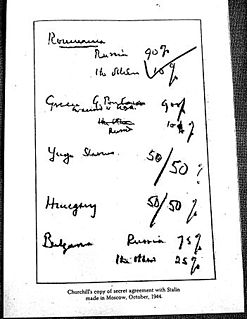 W
WThe percentages agreement was a secret informal agreement between British prime minister Winston Churchill and Soviet leader Joseph Stalin during the Fourth Moscow Conference in October 1944. It gave the percentage division of control over Eastern European countries, dividing them into spheres of influence. Franklin Roosevelt was consulted tentatively and conceded to the agreement. The content of the agreement was first made public by Churchill in 1953 in the final volume of his memoir. The US ambassador Averell Harriman, who was supposed to represent Roosevelt in these meetings, was excluded from this discussion.
 W
WThe Pillbox affair, also known as the Pillbox incident, was a military and political episode which occurred in Britain between November 1939 and January 1940 during the Second World War. The British War Minister, Leslie Hore-Belisha, visited France and the positions of the British Expeditionary Force (BEF) in mid-November.
 W
WPlan W, during World War II, was a plan of joint military operations between the governments of Ireland and the United Kingdom devised between 1940 and 1942, to be executed in the event of an invasion of Ireland by Nazi Germany.
 W
WThe Quebec Agreement was a secret agreement between the United Kingdom and the United States outlining the terms for the coordinated development of the science and engineering related to nuclear energy and specifically nuclear weapons. It was signed by Winston Churchill and Franklin D. Roosevelt on 19 August 1943, during World War II, at the First Quebec Conference in Quebec City, Canada.
 W
WThe Royal Naval Patrol Service (RNPS) was a branch of the Royal Navy active during both the First and Second World Wars. The RNPS operated many small auxiliary vessels such as naval trawlers for anti-submarine and minesweeping operations to protect coastal Britain and convoys.
 W
WSiebe Gorman & Company Ltd was a British company that developed diving equipment and breathing equipment and worked on commercial diving and marine salvage projects. The company advertised itself as 'Submarine Engineers'. It was founded by Augustus Siebe, a German-born British engineer chiefly known for his contributions to diving equipment.
 W
WThe Trading with the Enemy Act 1939 is an Act of the Parliament of the United Kingdom which makes it a criminal offence to conduct trade with the enemy in wartime, with a penalty of up to seven years' imprisonment. The bill passed rapidly through Parliament in just two days, from 3 to 5 September 1939, and the Act was passed on 5 September 1939, at the beginning of the Second World War. It is still in force.
 W
WThe Treachery Act 1940 was an Act of the Parliament of the United Kingdom effective during World War II to facilitate the prosecution and execution of enemy spies, suspended afterwards, and repealed in 1968 or 1973, territory depending. The law was passed in the month after Nazi Germany invaded France and Winston Churchill became prime minister, on 23 May 1940.
 W
WThe Treaty on the Final Settlement with Respect to Germany, or the Two Plus Four Agreement, was negotiated in 1990 between the Federal Republic of Germany and the German Democratic Republic, and the Four Powers which occupied Germany at the end of World War II in Europe: France, the Soviet Union, the United Kingdom, and the United States. In the treaty, the Four Powers renounced all rights they held in Germany, allowing a reunited Germany to become fully sovereign the following year. On the other hand, Germany agreed to confirm its acceptance of its existing border with Poland, and accepted that the borders of Germany after unification would correspond only to the territories then administered by West and East Germany, with the exclusion and renunciation of any other territorial claims.
 W
WThe UK-US relations in World War II comprised an extensive and highly complex relationships, in terms of diplomacy, military action, financing, and supplies. British Prime Minister Winston Churchill and American President Franklin D. Roosevelt formed close personal ties, that operated apart from their respective diplomatic and military organizations.
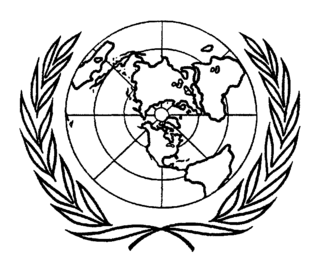 W
WThe United Nations Conference on International Organization (UNCIO), commonly known as the San Francisco Conference, was a convention of delegates from 50 Allied nations that took place from 25 April 1945 to 26 June 1945 in San Francisco, California, United States of America. At this convention, the delegates reviewed and rewrote the Dumbarton Oaks agreements of the previous year. The convention resulted in the creation of the United Nations Charter, which was opened for signature on 26 June, the last day of the conference. The conference was held at various locations, primarily the War Memorial Opera House, with the Charter being signed on 26 June at the Herbst Theatre in Civic Center. A square adjacent to the city's Civic Center, called "UN Plaza", commemorates the conference.
 W
WIn May 1940, during the Second World War, the British war cabinet was split on the question of whether to make terms with Nazi Germany or to continue hostilities. The main protagonists were the prime minister, Winston Churchill, and the foreign secretary, Viscount Halifax. The dispute escalated to crisis point and threatened the continuity of the Churchill government.
 W
WWashwood Heath is a ward in Birmingham, within the formal district of Hodge Hill, roughly two miles north-east of Birmingham city centre, England. Washwood Heath covers the areas of Birmingham that lie between Nechells, Bordesley Green, Stechford and Hodge Hill.
 W
WWinston Churchill was appointed First Lord of the Admiralty on 3 September 1939, the day that the United Kingdom declared war on Nazi Germany. He succeeded Neville Chamberlain as Prime Minister on 10 May 1940 and held the post until 26 July 1945. Out of office during the 1930s, Churchill had taken the lead in calling for British rearmament to counter the growing threat of militarism in Nazi Germany. As Prime Minister, he oversaw British involvement in the Allied war effort against the Axis powers. Churchill is seen as a victorious wartime leader who played an important role in defending Europe's liberal democracy against the spread of fascism, though some wartime events like the 1945 bombing of Dresden have generated controversy.
 W
WWomen of Steel is a bronze sculpture that commemorates the women of Sheffield who worked in the city's steel industry during the First World War and Second World War. A work of the sculptor Martin Jennings, it was unveiled in June 2016. Women of Steel was given the Keith Hayman Award in the Sheffield Design Awards 2016 and the Public Monuments and Sculpture Association's 2017 Marsh Award for Excellence in Public Sculpture.
 W
WThe Yalta Conference, also known as the Crimea Conference and code-named Argonaut, held February 4–11, 1945, was the World War II meeting of the heads of government of the United States, the United Kingdom, and the Soviet Union to discuss the postwar reorganization of Germany and Europe. The three states were represented by President Franklin D. Roosevelt, Prime Minister Winston Churchill, and Premier Joseph Stalin, respectively. The conference was held near Yalta in Crimea, Soviet Union, within the Livadia, Yusupov, and Vorontsov Palaces.